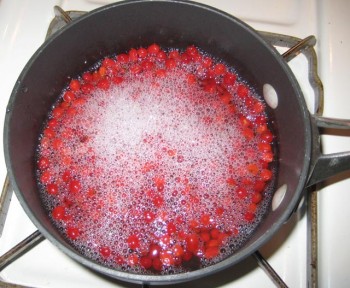
My mother always told me not to eat wild berries I found growing in the woods, and I have long heeded her advice with the exception of easy ones like blackberries, raspberries, and blueberries. That is, until recently, when I found a guide to wild edible berries at our local Fairplay, Colorado public library entitled Wild Berries of the West, by Betty B. Derig and Margaret C. Fuller (2001). So far, every berry I discover in the wilds here in the Colorado Rockies I can find in that book. It’s wonderful!
My most recent discovery is Sheperdia canadensis, also known as soapberry, soopolallie, or Canada buffaloberry. According to Plants of the Rocky Mountains (Kershaw et. al., 1998), S. canadensis is a spreading, deciduous shrub with small, bran-like, rust-colored scales on the undersides of leaves and young branches. The juicy, translucent berries are born on the female plants only, range from red to yellow, and feel soapy to the touch.
The nickname “soapberry” comes from the berries’ saponin content, which is an ingredient in many commercial foaming agents (Derig and Fuller) and the fact that the berries foam up when beaten (Kershaw) or cooked.
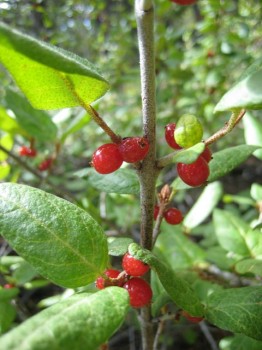
Once identified, I found several soapberry bushes growing around our house at 11,000 feet. According to both wild plant guides, native people would spread a hide on the ground beneath a soopolallie bush and beat it with a stick to knock off the berries. I considered trying this method, but then worried about the difficulty of separating out the dead berries and dry leaves afterwards. Instead, I ended up having moderate success simply stripping mature berries off the branches and letting them drop into a big Tupperware container underneath. I collected a pint in less than an hour.
A Hint of Paint Thinner
The foraging was successful. The only problem was that the soapberries were awful.
“It’s sweet at first,” Gregg said, upon popping a red berry into his mouth, but then his face scrunched up into a tortured expression shortly thereafter and he concluded: “and then…paint thinner.” I shared the sentiment.
So, how did our ancestors prepare these berries? One method, according to Derig and Fuller, was to whip raw berries with water to make a meringue-like dessert referred to as “Indian ice cream” by settlers. Kershaw mentions this technique too, but concludes that it “is rather bitter for modern-day tastes,” even when you add sugar.
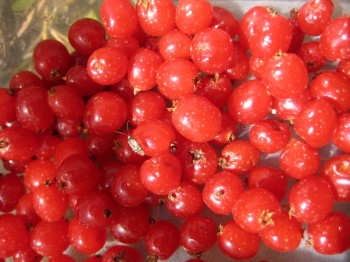
Soopolallie Jelly with a Kick
Intrigued as I was by the idea of whipping up raw berries into a tangy Cool Whip topping, I decided that my best bet for wringing out some of the bitterness was to cook the berries into jelly—maybe with some jalapeños as well, an idea that occurred to me because I was just about through a jar of blackberry jalapeño jelly gifted me by my friend Melissa, and also because my brother-in-law has caused me to develop a penchant for venison sausage served on crackers with cream cheese and pepper jelly.
Besides, jelly-making couldn’t be all that difficult, could it?
Beginner’s Luck
Lacking a recipe for soapberry jelly, I perused a few articles on Ehow and settled on a raspberry jelly recipe to bastardize for my purpose. I cooked my one pint of sudsy soopolallies and a finely chopped jalapeño together with just enough water to cover for a couple of minutes, mashed the mixture, cooked some more, and then strained out the juice with a thin mesh strainer because I had neither a jelly bag nor the patience to wait for the juice to drip through a coffee filter.
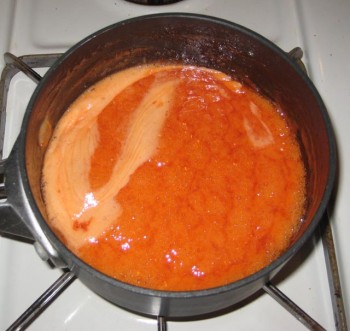
(In the meantime, Gregg’s mother was sitting in the living room with her hand over her mouth and nose because she can’t stand anything pepper-related, and it didn’t even occur to me that spicy peppers are peppers too. Oy.)
Next I discarded the thick stuff and put the juice back on the stove for the jelly-making. I added a rough estimate of pectin (like 1/7 of the package) and ¾ cup sugar and cooked it over low heat for a while, stirring, until I realized I was supposed to boil it for 10 minutes. Needless to say, it took forever to thicken, but it did thicken eventually on the stove, at which point I poured the jelly mixture into a jar and set it in the refrigerator. I ended up with about ½ cup of jelly. Not once did it occur to me how lucky I was that the stuff gelled successfully, for on a subsequent jelly-making attempt, Gregg read the pectin package’s strict instructions aloud, replete with warnings that the jelly might not set if the proportions are off. But more on that later…
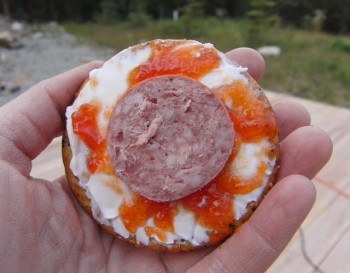
The next day I served soopolallie pepper jelly on crackers with cream cheese and beef summer sausage. (By the way bro, if you happen to read this, I don’t suppose you’d mind sending your sister-in-law some more of that venison sausage?) The jelly had a kick to it, as expected, although I’m not sure whether that’s due to the jalapeño on its own or to the paint thinner aftertaste.
Gregg loved the jelly and cracker snack combo. He said he didn’t notice an aftertaste, and helped himself to a second and third cracker to prove his point—but I myself can’t help but notice the sharp bite that settles on my tongue afterwards. Still, it’s not bad with the snack combo, and you can’t beat the fluorescent orange color of the jelly for visual appeal.
Warnings
Derig and Fuller warn that if you do succeed in getting over the soapberries’ bitter taste, don’t eat them “in quantity” lest they cause “intestinal distress.” (Thank goodness I could only manage to forage a pint full!)
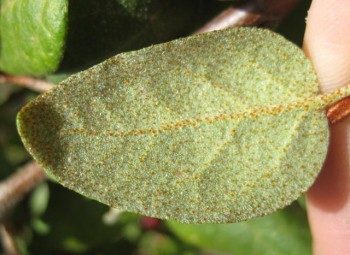
“The berries are rich in vitamin C and iron, but large amounts can cause diarrhea, vomiting, and cramps,” clarify Kershaw, et. al. How much is too much is beyond me, so I suppose it merits erring on the side of caution. As always, make sure to heed all warnings while cross referencing identifications in several guides. Then, eat only a small portion of an unfamiliar plant at first, observing effects for a 24 hour period before going at it full bore.
And last, please always keep in mind that “Wild Food Girl” or not, I am still very much a neophyte myself. Therefore, you should take everything you read here with a grain of salt—or in the case of soapberries, with several cups of sugar!

love the article. great experiment. i’ll try one of these if i should find some.
i have no idea how anyone can call the taste of the soapberry paintthinner
i have been eating them since i came out of my mother it is an aquired taste but once you have some you just cant get enough the health benefits alone are of great value i know that soapberries are packed with all sorts of nutrion in our culture they are dried or added to saskatoons to make a chew for the winter mmmmmmm
today i am going to make marmalade with the soapberries i picked last week
I absolutely love soapberries. I used to make juice them buy squishing them through a sieve then adding maple syrup and water. So good.
Now I live in Vancouver and am trying to figure out if they grow anywhere near here. I sure miss ’em.
I am definitely going to have to give the soapberries another try this year, ladies, after your comments. Shirley, if you have a marmalade recipe to share, that would be fantastic. Jen, I’ll have to try the maple syrup method too. Thanks so much for commenting.
Thanks for this article – I’m very interested in Buffaloberry because it’s a native shrub that fixes nitrogen in the soil. I’m hoping to raise a bunch of them from seed, in search of ones with larger berries, on the sweeter side. If they are like Autumn Olive (to which they are related), there is a high variability in the (eating) quality of the berries, and they are also very different tasting when ripe vs not-ripe. With Autumn Olives, my wife goes around to each shrub, tests if they have the chalky after-taste, then I known which shrubs to pick by tickling the berries off into a large basket. I’m not sure if the chalky after-taste is saponins, as with the Buffaloberry, and it’s highly variable which ones will have it. There are some improved varieties of Autumn Olive with larger and sweeter berries, but they are considered highly invasive, so using a native species in permaculture designs that require nitrogen-fixers would be highly preferred.
Thanks again,
Rob
I make “Indian Ice Cream” from the soapberry (shepherdia canadensis). Quarter cup berries to quarter cup sugar to 3 Tablespoons of water give or take a bit will make almost two cups of “ice cream. I place the ingredients in a shaker bottle (the kind with the little wire springy thing) and shake for about 5 minutes give or take. You will know when the “ice cream” is shook enough because the mixer wire thingy begins to get stuck in the thick foam and requires hard force to continue shaking. A whisk in a bowl will also work but it seems as though the shaker bottle works better. The flavor? Well it is not bad at all but I’m guessing that it is a taste that probably will not appeal to many folks